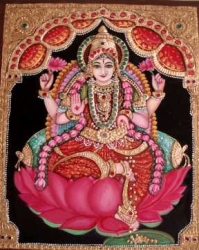Tanjore Art Lessons
 Students are taught
various techniques in preparing, finalizing and painting as special
art. Tanjore
paintings are gorgeous with brilliant colors adorned with gem stones
and gold foil. These are very expensive to buy, enjoy making it for
yourself and for gift giving. These paintings are supposed to bring
good luck, people place them in alters and decorate their
houses. They make perfect housewarming and wedding gifts loved by
collectors and art lovers of all ages.
Students are taught
various techniques in preparing, finalizing and painting as special
art. Tanjore
paintings are gorgeous with brilliant colors adorned with gem stones
and gold foil. These are very expensive to buy, enjoy making it for
yourself and for gift giving. These paintings are supposed to bring
good luck, people place them in alters and decorate their
houses. They make perfect housewarming and wedding gifts loved by
collectors and art lovers of all ages.
We have ongoing enrollment
REGISTRATION FORM
What is the origin of Tanjore art?
Tanjore art originated in the Thanjavur about 1600AD. This style of
art was patronised by the Vijayanagara Rajas along with classical
dance and music.
What are the main characteristics of Tanjore style of art?
Tanjore paintings are mostly Gods and
Goddess and in some instances saints. Tanjore paintings are known
for their rich colors and rounded faces with big eyes. Gold foils
along with precious and semi precious stones are intricately placed
in the paintings with extensive muckwork.
What are the steps that are involved in tanjore painting?
There are several steps in preparing Tanjore art.
1.Board: First the artist makes a preliminary sketch of the image on
the base, which is a piece of cloth pasted onto wood.
2.Stone: After the drawing is made, the jewellery and apparel in the
image are decorated with semi-precious stones.
3.Emboss: A mixture called "muk" is prepared using chalk powder and
African gum in a ratio of 2:1. The muk is applied in places around
the stones and other areas to give an embossed look.
4. Foil: Gold foil is pasted on top of this.
5. Paint: Finally, dyes are used to add color to the figures in the
paintings. The color brown is used for outlining the paintings. Red,
the distinctive mark of Thanjavur paintings, is generally used as
background. Sometimes, the color green color is also used. Lord
Vishnu is always represented with blue, whereas the goddesses are
denoted with yellow color and Lord Nataraja with chalk white.
6. Frame: Paintings can be mounted in one of two types of frames.
Plain wooden frame without much decoration or extra decorated wooden
frame in Chettinad style.
Are there different styles of painting tanjore art?
There are three types of Tanjore painting.
1. Classic: Classic Tanjore paintings are painted with bold, strong
and bright colors with high glitter gold foil.
2. Antique: Antique paintings are made with more sober, subtle
colors and plain backgrounds with subdued gold.
3. Embossed: Embossed paintings are similar to the classic style
but are embossed to give greater depth.
